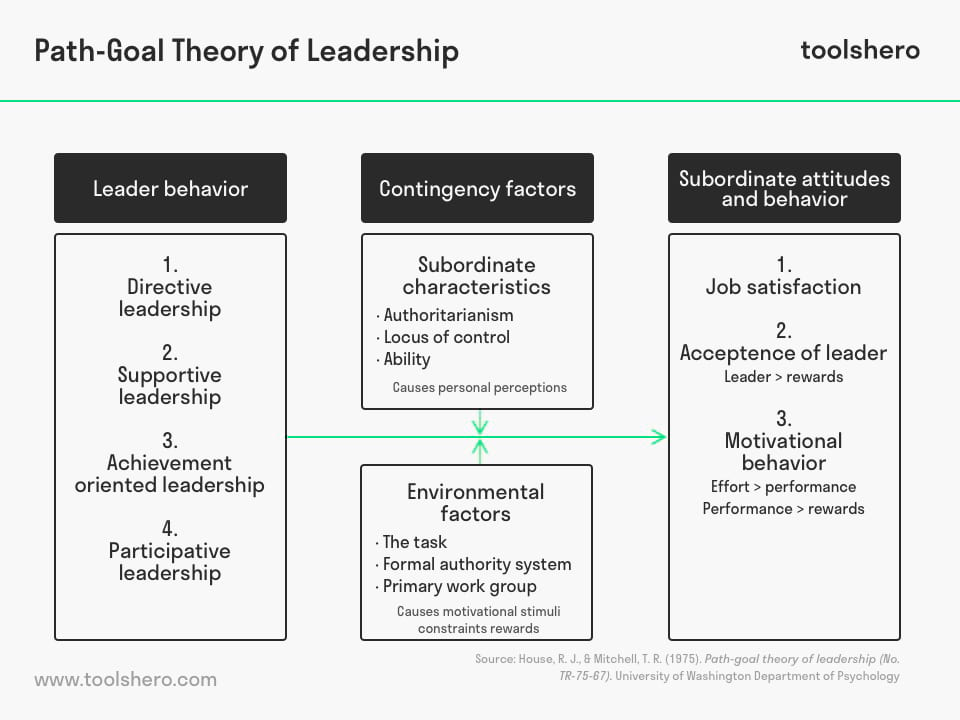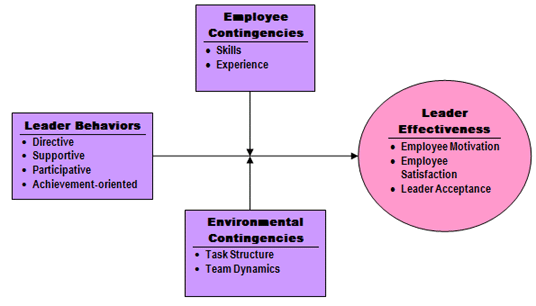Path-goal Theory Could Be Best Described as a ______.
See the answer See the answer done loading. From the managers in the office the RNs the LPNs and the home.

Chapter 12 Review Questions Part 2 Leadership True False 1
125 and that is evident in my career.

. Drawing heavily from research on what motivates follow-ers pathgoal theory first appeared in the leadership literature in the early 1970s in the works of Evans 1970 House 1971 House and Dessler. Followers are motivated if they think completing a task will result in a valuable payoff. Using the path-goal approach expectancy theory suggests that.
True 5 TF Participative leadership is effective with. In path-goal theory the main components. The path-goal theory can best be referred to as a set of processes in which leaders choose specific behaviors that are good for the employees needs and their working environment so.
Each of us answers to someone above us and each of us recognizes and acknowledges when goals have been met and when excellent care has been provided. -It provides a useful theoretical framework for understanding how various leadership behaviors affect followers satisfaction and work performance. -It provides a model that in certain ways is very.
This problem has been solved. Using the path-goal approach expectancy theory suggests that a. Pathgoal theory could be best described as a a.
Best with ambiguous tasks. TF According to path-goal theory achievement-oriented leadership is most effective in settings where followers are required to perform unambiguous tasks. What are strengths of path-goal theory.
The Path-Goal model is a theory based on explaining a leaders style or behavior that is best suited to the employee and workplace to achieve a common goal. Believe that outside circumstances control their lives. View Foundations of LDRS Quiz 6 from AA 1Pathgoal theory could be best described as a.
A leader should try to help followers reach their fullest potential. Pathgoal theory could be best described as a. It is difficult to use the theory fully when trying to improve the leadership process.
Path-goal theory could be best described as a ______. Path-goal theory could best described as a. The practical use of the theory is not valid.
The path-goal theory can be applied to any level of leadership Northouse 2016 p. House founder of Path-Goal theory believes that a leaders behavior is contingent to employee satisfaction employee motivation and employee performance. Environmental characteristics of the.
Match the Revised Path-Goal Theory leader behaviors with the appropriate descriptions. The need for directive leadership increases when employees. Achievement-oriented leadership may be used to encourage continued high performance but it could backfire if the targets are unclear and vague.
The expectancy theory of motivation states that follower motivation is dependent on 1 believing that they can do the work 2 their efforts will lead to goal attainment and that 3 they will earn a reward. Followers are motivated if they think completing a given task will result in a valuable payoff. Path-Goal theory states that a.
Answer of Path-Goal Leadership theory could be best described as a Group of answer choices Great person theory Transformational theory Motivational theory Trait. Vroom 1964 states that path-goal theory borrows from the motivation perspective of the expectancy theory as cited in Northouse 2016. This highly acclaimed theory was developed in the year 1971 by Robert House and revised once again in the year 1996.
4 TF A disadvantage of path-goal theory is that its approach could foster subordinate dependency. What style should the leader choose depends on two of the situational variables identified by the theory. -It attempts to integrate the motivation principles of expectancy theory into a theory of leadership.
Pathgoal theory is about how leaders motivate followers to accomplish. Great person theory b. It allows the leader to have a wider range of options as leader.
The goal of this activity is to help you to understand and differentiate among the different leader behaviors in the Revised Path-Goal Theory. The path-goal theory is defined as a leadership theory that specifies the behavior and style of a leader best suited to fit the work environment as well as the satisfaction and performance of his juniors to achieve a particular goal. It fails to determine the role of motivation.
Using the path-goal approach expectancy theory suggests that ______. The pathgoal theory also known as the pathgoal theory of leader effectiveness or the pathgoal model is a leadership theory developed by Robert House an Ohio State University graduate in 1971 and revised in 1996The theory states that a leaders behavior is contingent to the satisfaction motivation and performance of his or her subordinates.

Path Goal Theory Of Leadership Robert House Toolshero

The Major Components Of Path Goal Theory Download Scientific Diagram



Comments
Post a Comment